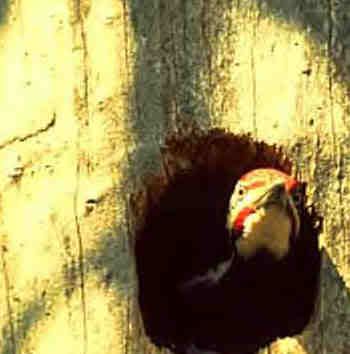April ~ the signalling of spring. Derived from the Latin word aprilis and the Greek "Aphrō", the abbreviation for Aphrodite. The Latin translation means "to open" in reference to the fertility of the earth, blooming of flora and birth of fauna. April is sacred to Venus or Aphrodite.
The first day of this fertile month was also Doug's birthday, and while I knew, now, that Doug's stint in California was not a Department of Defense project, as he'd originally claimed, nor would his communications be under high security watch, I sent him a brief email wishing him the best, and hoping he'd offer some hint or explanation for his prior avoidance behaviour. Several months had passed since my last contact and it was distressing to see him ignore me whilst we both were active in the same newsgroups, especially after I'd demonstrated what I believed was understanding and kindness.
Shortly thereafter a reply notification appeared in my email inbox.
Evolution has provided organisms with a range of means to escape the approach of another species, especially when their purpose is unknown. Both eyesight and hearing acuity aid birds in identifying an intruder. Likewise, camouflage and an ability to rapidly turn in flight are also employed to evade an intruder. Some scansorial birds, that is those that are tree climbers such as woodpeckers, employ other effective strategies for defense. Being cavity-dwellers, they bore small openings in the bark both above and below the cavity to release a cascade of phloem sap. The glue-like sap oozes down the trunk of the tree and stops crawling organisms in their tracks. Much effort is expended in making sure the sap continues to flow, as it guards the cavity from unwanted intruders and also serves as an effective means to trap insects.
The glue-like sap oozes down the trunk of the tree and stops crawling organisms in their tracks. Much effort is expended in making sure the sap continues to flow, as it guards the cavity from unwanted intruders and also serves as an effective means to trap insects.
When feeling threatened, birds have unique defense techniques, one being vocalisation. Possessing a broad range of calls, studies have shown that Aves use specific vocalisations to convey contextual information and assess motivation levels, communicate defense strategies or coordinate nest defense. These are known as alarm calls and they often vary in acoustic structure, relative to the situation. This strategy provides both referential and risk-based information. Indeed, avian alarm calls are subtle, complex and sophisticated. Even birds that don’t produce an alarm call often choose to associate with those that do and are a sort of second party beneficiary, if you will, to the defense mechanisms of the other population.
That said, when I opened the email that arrived, I was a little alarmed. Doug had responded to my birthday greeting within hours. He admitted that he'd received several emails from me in the past, but was sure I had him mixed up with someone else, and then went on to ask if I was the same "swiss" that posted on ILW. Of course, immediately, I replied telling him that I was absolutely sure I had not confused him with anyone else, hoped he was well and told him I had missed him.
The first day of this fertile month was also Doug's birthday, and while I knew, now, that Doug's stint in California was not a Department of Defense project, as he'd originally claimed, nor would his communications be under high security watch, I sent him a brief email wishing him the best, and hoping he'd offer some hint or explanation for his prior avoidance behaviour. Several months had passed since my last contact and it was distressing to see him ignore me whilst we both were active in the same newsgroups, especially after I'd demonstrated what I believed was understanding and kindness.
Shortly thereafter a reply notification appeared in my email inbox.
Evolution has provided organisms with a range of means to escape the approach of another species, especially when their purpose is unknown. Both eyesight and hearing acuity aid birds in identifying an intruder. Likewise, camouflage and an ability to rapidly turn in flight are also employed to evade an intruder. Some scansorial birds, that is those that are tree climbers such as woodpeckers, employ other effective strategies for defense. Being cavity-dwellers, they bore small openings in the bark both above and below the cavity to release a cascade of phloem sap.
 The glue-like sap oozes down the trunk of the tree and stops crawling organisms in their tracks. Much effort is expended in making sure the sap continues to flow, as it guards the cavity from unwanted intruders and also serves as an effective means to trap insects.
The glue-like sap oozes down the trunk of the tree and stops crawling organisms in their tracks. Much effort is expended in making sure the sap continues to flow, as it guards the cavity from unwanted intruders and also serves as an effective means to trap insects.When feeling threatened, birds have unique defense techniques, one being vocalisation. Possessing a broad range of calls, studies have shown that Aves use specific vocalisations to convey contextual information and assess motivation levels, communicate defense strategies or coordinate nest defense. These are known as alarm calls and they often vary in acoustic structure, relative to the situation. This strategy provides both referential and risk-based information. Indeed, avian alarm calls are subtle, complex and sophisticated. Even birds that don’t produce an alarm call often choose to associate with those that do and are a sort of second party beneficiary, if you will, to the defense mechanisms of the other population.
That said, when I opened the email that arrived, I was a little alarmed. Doug had responded to my birthday greeting within hours. He admitted that he'd received several emails from me in the past, but was sure I had him mixed up with someone else, and then went on to ask if I was the same "swiss" that posted on ILW. Of course, immediately, I replied telling him that I was absolutely sure I had not confused him with anyone else, hoped he was well and told him I had missed him.
What we call our despair is often only the painful eagerness of unfed hope ~ George Eliot

No comments:
Post a Comment